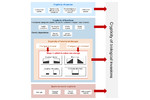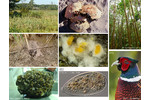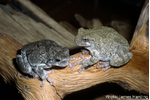Newcomers play cryptic: The impacts of invasive species are often difficult to predict
New Zealand and other islands have experienced invasions of rats and other species, Europe has seen the arrival of diseases such as the crayfish plague: invasive species can put native animal and plant species on the brink of extinction. They often go undetected for a long time, or their damaging impacts are not immediately clear. This phenomenon – referred to as crypticity – represents a huge challenge for the management of species communities and the conservation of biodiversity. This is the conclusion of an international team of researchers involving the Czech Academy of Sciences, Berlin’s Leibniz-Institute of Freshwater Ecology and Inland Fisheries (IGB), Freie Universität Berlin, Technische Universität Berlin, the University of Potsdam, India’s National Institute of Advanced Studies and the University of Vienna, Austria.
 It was impossible to foresee the devastating effects of Mediterranean mussels’ (Mytilus galloprovincialis) invasion along the South African coast, where the mussels have – after their introduction – started to settle on the eyestalks and mouthparts of the crabs Ovalipes trimaculatus; this has caused a mass mortality of the crabs.
It was impossible to foresee the devastating effects of Mediterranean mussels’ (Mytilus galloprovincialis) invasion along the South African coast, where the mussels have – after their introduction – started to settle on the eyestalks and mouthparts of the crabs Ovalipes trimaculatus; this has caused a mass mortality of the crabs.
The impacts of invasive species on native fauna and flora can be devastating. A major problem is that their introductions often go unnoticed, or their damaging effects are only detected with delay. Since these processes are often hard to predict, it is difficult to assess the extent, impacts and risks of biological invasions, and to plan effective control measures. An international team of researchers has developed a conceptual framework for dealing with these aspects of uncertainty.
“Not all non-native species are problematic. In fact, we appreciate some of them, for example crop plants such as the potato, which was brought to Europe in the 16th century. Some non-native species, however, may be a threat to native species and their communities,” stated Jonathan Jeschke, IGB researcher and co-author of the study, explaining the ambivalent role of alien species. Jeschke also coordinates the Invasion Dynamics Network (InDyNet), an international network of scientists studying temporal dynamics in biological invasions, from which the current study emerged.

Figure. Examples of different forms of crypticity in invasive alien species.
A) common reed (Phragmites australis) populations in North America form a complex and evolving patchwork of native and introduced subspecies and their hybrids );
B) Mediterranean mussel (Mytilus galloprovincialis) attachment to the eyestalks and mouthparts of a crab Ovalipes trimaculatus leads to massive mortalities in the latter species;
C) red quinine tree (Cinchona pubescens) introduction on the Galápagos Islands resulting in unforeseen and changing characteristics and effects;
D) red swamp crayfish (Procambarus clarkii) invasion in Doñana producing novel and unforeseen dispersal pathways of native and alien plants and invertebrates through interactions with their predators;
E) introduced beech scale (Cryptococcus fagisuga) does not produce direct effects on North American beech trees, but it predisposes them to attack by the fungus Neonectria faginata;
F) decline of larger specimens in zebra mussel (Dreissena polymorpha) populations in the Hudson River alters its filter-feeding impact on zooplankton;
G) pollen from the plantations of alien Monterey pine (Pinus radiata) in New Zealand was found in Southwest Pacific trenches, where it represents a novel food resource for deep-sea benthic organisms; photomicrograph shows a gromiid specimen from the Tonga Trench (10,811 m water depth) with ingested P. radiata pollen;
H) introduced pheasants (Phasianus colchicus) in the UK acting as reservoirs for caecal nematodes Heterakis gallinarum that caused population declines in the native grey partridge (Perdix perdix).
Whether an invasive species is quickly detected depends on its ecological properties, its new habitat, and the circumstances of its introduction. If, for instance, the imported species closely resembles a native species, genetic analyses are necessary to tell them apart. Many species also go undetected for a long time because they occur only rarely or populate habitats that are difficult to access – examples include belowground and aquatic ecosystems. The management of alien species is already on the political agenda, e.g. in the Aichi targets, the Sustainable Development Goals and an EU regulation on invasive alien species. At the same time, the authors of the study believe that crypticity has received too little attention so far.
“We have developed a set of research methods and tools that will enable us to determine detrimental species and properties, as well as spatial and temporal changes, more effectively. Citizen scientists, for example, can provide support by helping researchers to find invasive species; while long-term monitoring and research help us to determine critical developments in good time,” stated Ivan Jarić, a researcher from the Biology Centre of the Czech Academy of Sciences and lead author of the study. Jarić and his colleagues are working to ensure their proposals are included in concepts for the management of alien species.
More information about the results of this study can be found in the scientific paper:
Jarić, I., Heger, T., Castro Monzon, F., Jeschke, J.M., Kowarik, I., McConkey, K.R., Pyšek, P., Sagouis, A. and Essl, F. (2019). Crypticity in biological invasions. Trends in Ecology and Evolution doi:10.1016/j.tree.2018.12.008
https://www.cell.com/trends/ecology-evolution/fulltext/S0169-5347(18)30300-8















